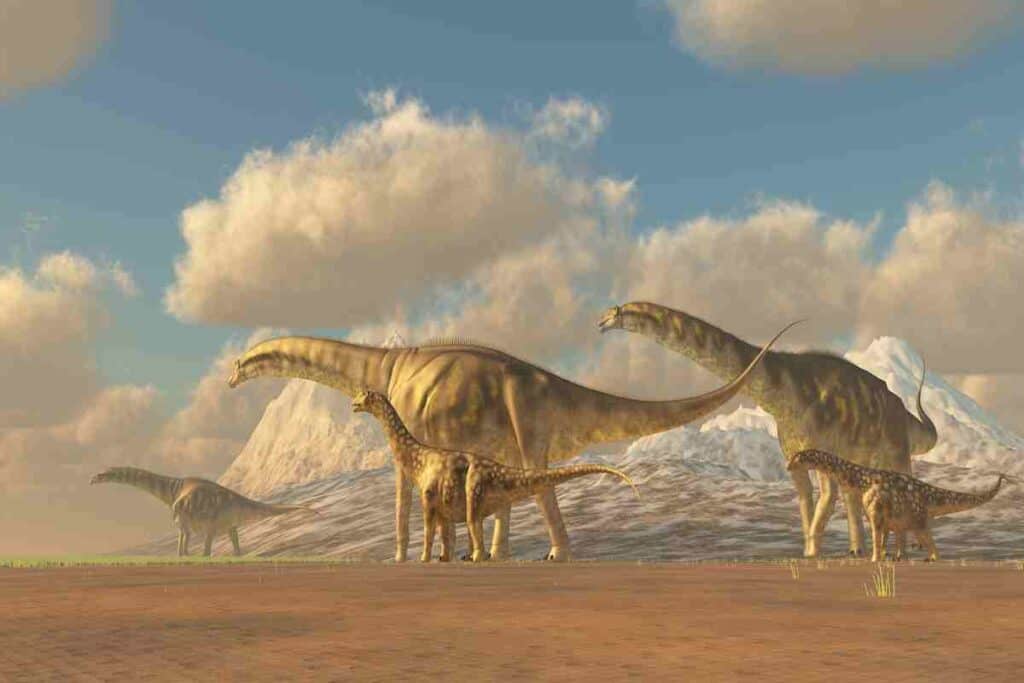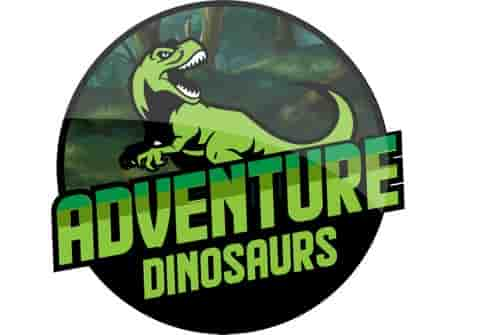Of all the families of dinosaurs, there is something special about the long-necked sauropods. From the well-known Brontosaurus (Apatosaurus) to the Diplodocus and the Argentinosaurus, you still want to know more about them. You would love to someday learn about all the sauropods, but how many existed?
In general, there are over 210 species of sauropods, including upwards of 175 genera. According to Wikipedia, sauropods are descendants of surprisingly small-sized ancestors, so scientists find both large and small sauropods. They are found on all continents. Some species are identified with just a few large bones or vertebrae, and new sauropod fossils are still being found almost every year. The latest sauropod to be discovered at the time of this writing is the Australiatitan.
If you want to learn more about sauropod groups, where their fossils are scattered, and what a sauropod family tree might have looked like, you’ve come to the right place. We have lots of fascinating information to share ahead, so make sure you keep reading!
What Are the Key Groups of Sauropods? What Is the Largest Sauropod?
As mentioned above, there are over 210 species of sauropods so far described and classified in the world, taking into consideration a 2011 published study (Source) and (Source) the latest discoveries of sauropods.
Outside of formal classification and phylogeny of sauropods, one way to group sauropods is with these four main groups – prosauropods, sauropods, titanosaurs, and dicraeosaurs.
Let’s take a closer look.
Prosauropods
The earliest group of sauropods were appropriately known as prosauropods. The last of the prosauropods died 180 to 205 million years ago during the Early Jurassic Period. It’s believed that prosauropods were herbivorous, even though experts believe that prosauropods might have come from carnivorous ancestors.
The Plateosaur is by far the best-known prosauropod. Its name translates to “broad lizard.” The Plateosaur was alive during the Late Triassic Period, making its home in what is today North America and parts of Northern and Central Europe.

Three species of Plateosaur have been identified, the first of which was uncovered back in 1834. The Plateosaur was bipedal with a spine that included almost a dozen cervical vertebrae. Its skull was tiny, and its tail had up to 40 vertebrae. Like a T. Rex, the Plateosaur had small arms. Plateosaur was herbivorous.
Sauropods
Evolving from prosauropods are sauropods, which are part of the Sauropoda group. The name means “lizard-footed.” Sauropods are known for their sturdy, thick legs and tiny heads, lengthy tails, and equally long necks. Their lifespan was from the Early Jurassic Period through the Late Triassic Period.
We touched on some of the most notable sauropod species in the intro, including the Diplodocus and Brontosaurus. Others include the Apatosaurus, Barosaurus, Nigersaurus, and the Haplocanthosaurus.
Like their prosauropod ancestors, sauropods were herbivorous. Their tall necks would have allowed them to reach high into the trees and munch on leaves in ways that many other dinosaurs could not.
Titanosaurs
The third group of sauropod dinosaurs is the titanosaurs. These dinosaurs lived during the Late Cretaceous Period and were significantly sized sauropods. For instance, one titanosaur known as the Patagotitan weighed 76 tons and measured 121 feet long. It might be the largest sauropod.
The size of titanosaurs in relation to other sauropod genera is interesting. As the Patagotitan proves, some titanosaurs were massive. Yet others were among the smallest sauropods in existence.
Although we don’t know a lot about the head shape or size of titanosaurs, it’s believed to be similarly sized to the sauropods that came before it. However, some titanosaurs, such as the Nemegtosaurus and the Rapetosaurus, had diplodocid-like heads. The Sarmientosaurus’ head was rather like a brachiosaurid.
The neck length of titanosaurs matched other sauropods, but their tails were shorter. These dinosaurs also had broader chests and thicker limbs. Titanosaurs were still herbivores.
Dicraeosaurs
The dicraeosaurs in the dicraeosauridae group have included diplodocids. Hence, the dicraeosaurs are considered a Diplodocidae sister group. Dicraeosaurs existed in South America, Africa, Asia, and North America between the Middle Jurassic Period and the Early Cretaceous Period. At that time, the Amargasaurus was still roaming the earth.
The classification of dicraeosaurs is still hotly debated upon to this day. The Dystrophaeus and Dyslocosaurus could have been dicraeosaurs, but that’s not quite clear.
Other species that were more assuredly dicraeosaurs include the Brachytrachelopan, the Dicraeosaurus, the Suuwassea, and the Amargasaurus. What’s interesting about those four species is the varying neck sizes.
The Amargasaurus doesn’t have a long neck compared to many previous sauropods (especially titanosaurs), but their necks are still longer than the Brachytrachelopan, which has an incredibly short neck.
It tells us that evolutionarily, longer necks must not have worked for sauropods anymore, so they grew out of them, so to speak.
That’s interesting, considering that dicraeosaurs were still herbivorous. Experts believe the dinosaurs fed lower on the ground compared to higher in the trees.
Did Sauropods Live on Every Continent? How Many Sauropod Fossils Have Been Found?
The groups of sauropods as described above lived for millions of years altogether. With such a collectively long lifespan, surely the sauropod clade could have traveled much of the world? Just how far-ranging are their fossils?
Indeed, sauropods did live on every continent, and we need to look no further than titanosaurs for proof. Titanosaurs have genera on each of the seven continents. Other sauropods outside of titanosaurs might have lived in the most frequent areas include Argentina, North America, and China.
In Patagonia, Argentina, a fossil of the titanosaur known as the Patagotitan was recovered in 2012. That explains the dinosaur’s name.
Wyoming is a frequent site of sauropod fossils as well, especially the Howe Quarry.
Some of the Howe Quarry sauropod fossils include tailbones, back and neck vertebrae, ribs, teeth, and leg bones dated to around 155 million years ago. Most of the bones were believed to have belonged to a Diplodocus, but other teeth were from carnivorous theropods.
The most significant Chinese sauropod fossil discovery was undoubtedly that of the Mamenchisaurus, which was one of the longest-necked sauropods around. Its neck was about half as long as its body.
Areas in China such as the Yunnan Province and Sichuan Basin have held these long-hidden fossils, which could have dated back to the Late Jurassic Period’s Oxfordian stage.
Although there’s still plenty that we don’t know about the Mamenchisaurus, we would have known even less if not for these fossils being uncovered. For instance, we can almost certainly say that the Mamenchisaurus had 19 neck vertebrae, at least in some species. Others had 18 vertebrae.
We can also say that the average size of this sauropod was anywhere from 49 feet to 115 feet long. Its neck might have been kept long and straight, mostly because it couldn’t move down very far.
The dinosaur had a sled or forked chevrons around the center of its tail for projecting itself forward. Such chevrons are also a trait of diplodocids.
The Sauropod Family Tree – A Quick Look at the Classification of Sauropods
In this last section, I thought to cover the classification of sauropods, creating a family tree of sorts. I want to note that all paleontologists agree on classifications of sauropods (not to mention other dinosaurs), and it is evolving as new genera and species are discovered. However, the following information is accurate from the point of view that the scientific community well accepted this 2011 classification.
As we mentioned in the intro, the most recent sauropod classification was compiled in 2011, as detailed in the journal Biological Reviews of the Cambridge Philosophical Society from that same year.
Some dinosaur families are missing, such as the Nemegtosauridae, and species are excluded. That said, here’s the most current classification.
Sauropoda
The first classification is Sauropoda, which includes only two dinosaur species, the Vulcanodon and the Antetonitrus. The Vulcanodon was an Early Jurassic dinosaur that was 36 feet long, with fossils uncovered in southern Africa.
The Antetonitrus is another African-located dinosaur, this time from the Early Jurassic Period. It’s believed to be an early sauropod, although it’s not clear if it was a prosauropod. More than likely, it wasn’t.
Eusauropoda
From the Sauropoda class, we go to the Eusauropoda class next. The name translates to “true sauropods” and refers to sauropods outside of vulcanodontids. These long-necked herbivorous dinosaurs lived in today’s Africa, Australia, Asia, North America, Europe, and South America.
The dinosaurs in this classification are the Spinophorosaurus, the Barapasaurus, and the Patagosaurus (which is different than the Patagotitan).
Mamenchisauridae
The Mamenchisauridae class is a small one, including only the Mamenchisaurus and the Omeisaurus. We’ve talked about the Mamenchisaurus, but what about the Omeisaurus? This Middle Jurassic dinosaur weighed about 9.8 tons on average and was 66 feet long.
The Omeisaurus’ neck was quite lengthy, measuring 30 feet alone. That’s half the dinosaur’s length! Up to eight Omeisaurus species are believed to exist.
Neosauropoda
Branching off the Eusauropoda class is the Neosauropoda class, which includes the Cetiosaurus and Jobaria. Neosauropoda dinosaurs likely lived in the Late Jurassic Period, but some were alive during the Cretaceous Period as well.
Neosauropoda dinosaurs had thick legs and long necks and were regarded as quite large as a Sauropoda subgroup.
Diplodocoidea
The Neosauropoda group is the Diplodocoidea, which we’ve discussed throughout this post.
Rebbachisauridae
The Rebbachisauridae class branches from Diplodocoidea and includes the Nigersaurus and the Limaysaurus. Rebbachisauridae is a dinosaur class that lived during the Cretaceous Period in Central Asia, Europe, North America, Africa, and South America.
Dicraeosauridae
Another branch of the Diplodocoidea is the Dicraeosauridae class, which includes the above-described Dicraeosaurus and the Amargasaurus.
Diplodocidae
In the Diplodocidae class are the Apatosaurus, the Barosaurus, and the Diplodocus. These sauropods were some of the most significantly sized, with average lengths of 112 feet common among the dinosaurs.
Macronaria
Going back to the Neosauropoda, Macronaria branches off from there. These sauropods had an external naris, which is a significantly sized nasal opening that was even larger than their eye openings or orbits.
Macronaria dinosaurs likely lived during the Middle Jurassic Period and the Late Cretaceous Period. Their fossils have been uncovered worldwide, from Tanzania to China, Portugal, the US, and Argentina.
Titanosauriformes
That brings us to Titanosauriformes, a more advanced class of Macronaria sauropods.
Titanosauria
From the Titanosauriformes come the dinosaurs in the Titanosauria class that we covered earlier. The class includes the Phuwiangosaurus. This Early Cretaceous dinosaur, uncovered in Thailand’s Sao Khua Formation, measured about 82 feet long.
Saltasauridae
Branching off the Titanosauria class is the last sauropod class, the Saltasauridae. Nicknamed after Argentina’s Salta region, the Saltasauridae dinosaurs were herbivorous, large creatures that reached average lengths of 112 feet.
These dinosaurs were among the last living sauropods, as they went extinct during the Upper Cretaceous Period. The dinosaur species in the class include Malawisaurus, Rapetosaurus, Isisaurus, and Saltasaurus.
Conclusion
Sauropods sure are a fascinating bunch! I’m still amazed at how many sauropod species there are and their distribution worldwide across the continents. Nothing captures the imagination as much as seeing a sauropod skeleton in a museum, especially the giant ones like the Dreadnoughtus or the Diplodocus.
Who knows what sauropod dinosaur discovery awaits in the near future as modern technology advances and scientists find more sauropod fossils. Maybe one day, the number of sauropods will reach even 300 to 400 species!
